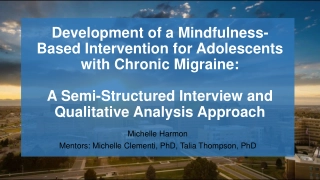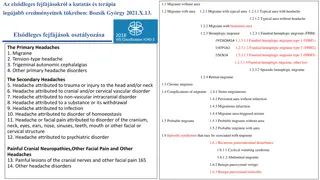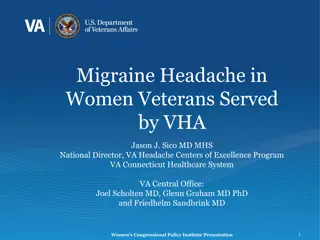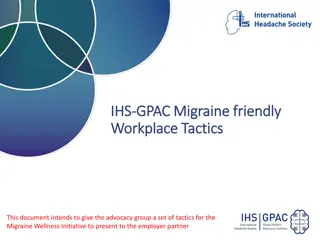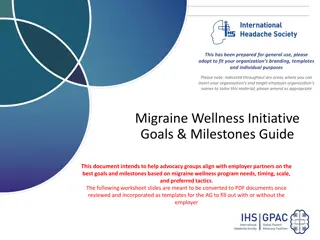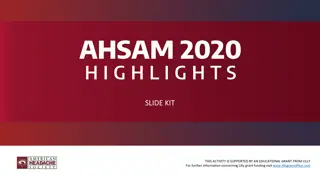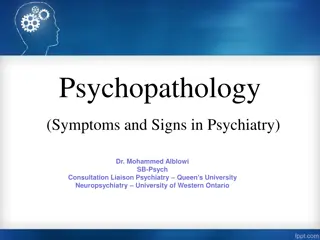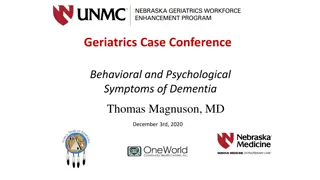Understanding Migraine: Types, Classification, and Symptoms
Migraine is a complex neurological condition characterized by severe headaches often accompanied by other symptoms. The classification of migraines includes those with and without aura, chronic migraines, and childhood periodic syndromes. Complications and disorders associated with migraines are also discussed, along with the International Classification of Headache Disorders editions. The presentation provides insights into different types of migraines, such as hemiplegic migraine and retinal migraine. Additionally, other primary headache disorders like cough headache, exercise headache, and thunderclap headache are outlined.
Download Presentation

Please find below an Image/Link to download the presentation.
The content on the website is provided AS IS for your information and personal use only. It may not be sold, licensed, or shared on other websites without obtaining consent from the author. Download presentation by click this link. If you encounter any issues during the download, it is possible that the publisher has removed the file from their server.
E N D
Presentation Transcript
(+/-) ( 33%, 72%) ( 11%, 35%) ( 20%, 56%) ( 20%, 56%) ( 4%, 40%)
- Migraine without aura (formerly, common migraine) Probable migraine without aura Migraine with aura (formerly, classic migraine) Probable migraine with aura Chronic migraine Chronic migraine associated with analgesic overuse Childhood periodic syndromes that may not be precursors to or associated with migraine Complications of migraine Migrainous disorder not fulfilling above criteria The second edition of the International Classification of Headache Disorders (ICHD)
- 1.2 Migraine with aura 1.2.1 Migraine with typical aura 1.2.1.1 Typical aura with headache 1.2.1.2 Typical aura without headache 1.2.2 Migraine with brainstem aura 1.2.3 Hemiplegic migraine 1.2.3.1 Familial hemiplegic migraine (FHM) 1.2.3.2 Sporadic hemiplegic migraine 1.2.4 Retinal migraine The third (beta) edition of the International Classification of Headache Disorders (ICHD)
4. Other primary headache disorders 4.1 Primary cough headache 4.2 Primary exercise headache 4.3 Primary headache associated with sexual activity 4.4 Primary thunderclap headache 4.5 Cold-stimulus headache 4.6 External-pressure headache 4.7 Primary stabbing headache 4.8 Nummular ( ) headache 4.10 New daily persistent headache (NDPH) The third (beta) edition of the International Classification of Headache Disorders (ICHD)
Cortical Spreading Depression Cortical spreading depression Activation Trigeminovascular system Neurogenic inflammation. Sensitization
Cortical spreading depression is a self-propagating wave of neuronal and glial depolarization that spreads across the cerebral cortex. The activation of trigeminal afferents by cortical spreading depression in turn causes inflammatory changes in the pain-sensitive meningesthat generate the headache of migraine through central and peripheral reflex mechanisms. How cortical spreading depression activates the pain sensitive trigeminal afferent neurons? It involves the opening of neuronal pannexin-1 megachannels and subsequent activation of caspase-1, followed by the release of the proinflammatorymediators, activation of nuclear factor kappa-B in astrocytes, and transduction of the inflammatory signal to trigeminal nerve fibers around pial vessels. (Cortical spreading depression explains the aura, and the prolonged activation of trigeminal nociception, explains the headache). Trigeminovascularsystem consists of small caliber sensory neurons that originate from the trigeminal ganglion and upper cervical dorsal roots. These sensory neurons project to innervate large cerebral vessels, pial vessels, dura mater, and large venous sinuses. There is convergence of the projections from the upper cervical nerve roots and the trigeminal nerve at the trigeminal nucleus caudalis. From the trigeminal nucleus caudalis, fibers that are involved in the localization of pain ascend to the thalamus and to the sensory cortex. Stimulation of the trigeminal ganglion results in release of vasoactive neuropeptides, including substance P, calcitonin gene-related peptide, and neurokinin A. Release of these neuropeptides is associated with the process of neurogenic inflammation. The two main components of this sterile inflammatory response are vasodilation (calcitonin gene-related peptide is a potent vasodilator) and plasma protein extravasation. Neurogenic inflammation is thought to be important in the prolongation and intensification of the pain of migraine. Neurogenic inflammation may lead to the process of sensitization. Sensitizationrefers to the process in which neurons become increasingly responsive to nociceptive and non-nociceptivestimulation. Sensitization is likely responsible for many of the clinical symptoms of migraine, including the throbbing quality of the pain, the worsening of pain with coughing, bending, or sudden head movements, hyperalgesia(increased sensitivity to painful stimuli), and allodynia (pain produced by normally non-noxious stimulation).
Triggers Various precipitants of migraine events have been identified, as follows: Hormonal changes, such as those accompanying menstruation (common), pregnancy, and ovulation Stress Excessive or insufficient sleep Medications (eg, vasodilators, oral contraceptives[46]) Smoking Exposure to bright or fluorescent lighting Strong odors (eg, perfumes, colognes, petroleum distillates) Head trauma Weather changes Motion sickness Cold stimulus (eg, ice cream headaches) Lack of exercise Fasting or skipping meals Red wine Certain foods and food additives have been suggested as potential Caffeine Artificial sweeteners (eg, aspartame, saccharin) Monosodium glutamate (MSG) Citrus fruits Foods containing tyramine (eg, aged cheese) Meats with nitrites
1. Migraine prodrome (77%of cases) Affective or vegetative symptoms that appear 24 to 48 hours prior to the onset of headache. Frequently reported prodromal symptoms include increased yawning, euphoria, depression, irritability, food cravings, constipation, and neck stiffness.
2. Aura ( ) (25%of cases) Features of migraine aura are as follows: May precede or accompany the headache phase or may occur in isolation Usually develops over 5-20 minutes and lasts less than 60 minutes Most commonly visual but can be sensory, motor, language or any combination Visual symptoms may be positive or negative: The most common positive visual phenomenon is the scintillating scotoma, an arc or band of absent vision with a shimmering or glittering zigzag border
3. Headache Signs and symptoms Throbbing or pulsatile headache, with moderate to severe pain that intensifies with movement or physical activity Unilateral and localized pain in the frontotemporal and ocular area, but the pain may be felt anywhere around the head or neck Pain builds up over a period of 1-2 hours, progressing posteriorly and becoming diffuse Headache lasts 4-72 hours Nausea (80%) and vomiting (50%), including anorexia and food intolerance, and light- headedness Sensitivity to light and sound Physical : Cranial/cervical muscle tenderness Horner syndrome (ie, relative miosis with 1-2 mm of ptosis on the same side as the headache), Conjunctival injection, Tachycardia or bradycardia, Hypertension or hypotension
4. Postdrome The patient may experience a postdromal phase, during which sudden head movement transiently causes pain in the location of the antecedent headache. During the postdrome, patients often feel drained or exhausted, although some report a feeling of mild elation or euphoria
Migraine with brainstem aura It occurs more often in females than in males. Onset is usually between ages 7 to 20. The auras consist of some combination of vertigo, dysarthria, tinnitus, diplopia, ataxia, decreased level of consciousness, and hypacusis. Hemiplegic migraine igraine with aura is the presence of motor weakness as a manifestation of aura in at least some attacks. Retinal migraine Repeated attacks of monocular scotomata or blindness lasting less than one hour, associated with or followed by headache. Irreversible visual loss may be a complication of retinal migraine (Migrainous infarction) Chronic migraine Headache occurring 15 or more days a month for more than three months. The characteristics of the headache may change from day to day or even within the same day.
Status migrainosus is a debilitating migraine attack lasting for more than 72 hours Persistent aura without infarction is defined by aura symptoms persisting for one week or more with no evidence of infarction on neuroimaging Migrainous infarction is defined by a migraine attack, occurring in a patient with migraine with aura, in which one or more aura symptoms persist for more than one hour and neuroimaging shows an infarction in a relevant brain area ( Migraine aura-triggered seizure is a seizure triggered by an attack of migraine with aura
(Tension-type headache) The second-most prevalent disorder in the world The current pathophysiologic model of TTH posits that peripheral activation or sensitization of myofascial nociceptors are most likely of major importance in episodic TTH, while sensitization of pain pathways in the central nervous system due to prolonged nociceptive stimuli from pericranial myofascial tissues seems to be responsible for the conversion of episodic to chronic TTH Symptoms are that of a mild to moderate intensity, bilateral, nonthrobbing headache without other associated features. Descriptions of TTH pain are characteristically nondescript: "dull," "pressure," "head fullness," "head feels large," or, more descriptively, "like a tight cap," "band-like," or a "heavy weight on my head or shoulders."
( . Paracetamol 1 gr x4) ( Naproxen 500mg x2) ( ) - agonistic effects on the 5-HT1Dreceptors agonistic effects on the 5-HT1B and 5-HT1Dreceptor 1. vasoconstriction of pain producing intra cranial extracerebral vessels by a direct effect on vascular smooth muscle. 2. inhibition of vasoactive neuropeptide release by trigeminal terminals innervating intracranial vessels and the dura mater. 3. inhibition of nociceptive neurotransmission within the trigeminocervical complex in the brainstem and upper cervical spinal column.
Choosing pharmacologic therapy Metoprolol, propranolol, and timolol ( 'Beta blockers' ) Amitriptyline and venlafaxine ( 'Antidepressants' ) Valproate and topiramate ('Anticonvulsants' ) Erenumab, fremanezumab, galcanezumab, eptinezumab, rimegepa nt, and atogepant ( 'CGRP antagonists' )
Trigeminal autonomic cephalgias (TAC) (Costen) Paroxysmal hemicrania Short-lasting, unilateral, neuralgiform headache attacks with conjunctival injection and tearing (SUNCT) Hemicrania continua Cluster headache . . ( . Tolosa-Hunt)
Triggers of pain attacks Chewing, talking, or smiling Drinking cold or hot fluids Touching, shaving, brushing teeth, blowing the nose Encountering cold air from an open automobile window Pain localization Patients can localize their pain precisely In 60% of cases, the pain shoots from the corner of the mouth to the angle of the jaw In 30%, pain jolts from the upper lip or canine teeth to the eye and eyebrow, sparing the orbit In less than 5% of cases, pain involves the ophthalmic branch of the facial nerve The pain qualities Characteristically severe, paroxysmal, and lancinating Commences with a sensation of electrical shocks in the affected area Crescendos in less than 20 seconds to an excruciating discomfort felt deep in the face, often contorting the patient's expression Begins to fade within seconds, only to give way to a burning ache lasting seconds to minutes Pain fully abates between attacks, even when they are severe and frequent Attacks may provoke patients to grimace, hence the term "tic douloureux"


